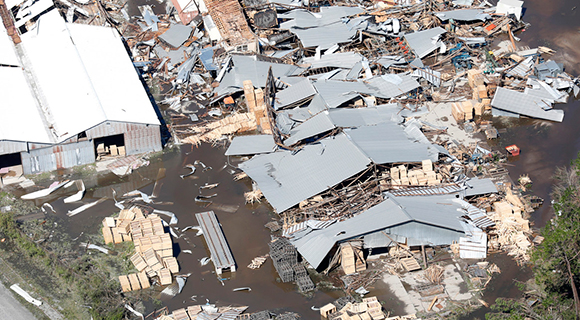VIDEO: U.S. Department of Defense Supports Hurricane Michael Response
By Claudette Roulo, U.S. Department of Defense // October 14, 2018
Emergency responders conducting initial Hurricane Michael damage assessment
ABOVE VIDEO: U.S. Northern Command and its National Guard and Defense Department partners are working with the Federal Emergency Management Agency to respond in areas hit by Hurricane Michael, Northcom officials said.

BREVARD COUNTY, FLORIDA – U.S. Northern Command and its National Guard and Defense Department partners are working with the Federal Emergency Management Agency to respond in areas hit by Hurricane Michael, Northcom officials said.
The storm made landfall Oct. 10 in the Florida Panhandle and left a trail of damage and death from Florida to Virginia. Michael had the highest wind speeds of any hurricane to hit the United States since 1992’s Hurricane Andrew, according to the National Hurricane Center.
Emergency responders are conducting initial assessments of the damage, officials said, and FEMA Administrator Brock Long said in a news conference today that he expects the death toll, already at 11, to climb.
“We still haven’t gotten into some of the hardest-hit areas,” he said. One of those areas, Mexico Beach, Florida, is about 15 miles from Tyndall Air Force Base. The town of about 1,100 people took a direct hit from the storm’s eye, Long said, as well as storm surge of up to 14 feet.
“Very few people live to tell what it is like to experience storm surge,” he said, noting that storm surge is responsible for most of the damage and loss of life in hurricanes.
The Coast Guard response is focused on safety of life, damage assessment, and reopening waterways, Coast Guard Capt. Kailie Benson said. “So far, the Coast Guard has conducted … 129 rescues and one animal rescue,” she said. Coast Guard cutters, aircraft, helicopters and shallow-water boat teams are deployed to the area.
In addition to conducting search and rescue and debris-clearing operations, the Coast Guard’s shallow-water response teams transported 142 nursing home residents to Pensacola Hospital, Benson said.

Army Corps of Engineers
More than 130 personnel are deployed or supporting the response remotely, said Charles R. “Ray” Alexander, the Army Corps of Engineers’ director for contingency operations.
“Today continues to be a day of assessments, movement of personnel and equipment and water management for needed reservoirs throughout the area,” he said.
“In terms of dam and levee safety, our initial assessment is most of our flood-risk projects escaped unharmed,” he said. “We do have some hydropower dams with minor damage in Georgia, but not impacting operations.”
Significant rain in southwest Virginia last night elevated the Dan River, Alexander said. “Those waters will make their way into our John H. Kerr Reservoir, which had sufficient capacity to accommodate that,” he added.
Corps power teams are bringing generators from Georgia and Alabama to provide temporary power to the affected areas, he said.
Survey teams are working today with the Coast Guard and the National Oceanic and Atmospheric Administration to assess damage to the Gulf Intracoastal Waterway and Port St. Joe, Florida.
Other teams are prepared to conduct damage assessments for military installations in the area, Alexander said.

DOD Support Summary
- Helping Hands
About 5,000 DOD personnel, half of whom are National Guard, have deployed to the affected areas to support hurricane relief efforts. Active duty, National Guard, U.S. Army Corps of Engineers or Defense Logistics Agency personnel are deployed from 12 states and the District of Columbia. - Coordination
Northcom has deployed a defense coordinating officer and a defense coordinating element to the emergency operations center in Tallahassee, Florida. These DCO/Es are specially trained military officers who provide DOD regional knowledge, requirements validation and liaison support in order to coordinate the military’s response to FEMA mission assignments. - Commander
Defense Secretary James N. Mattis approved Army Brig. Gen. Rafael Ribas as the dual-status commander for Florida. Ribas will head a joint task force made up of National Guard (Title 32 and state active duty) and federal military (Title 10) forces in a civil support mission. - Air and Water
About 100 helicopters, 20 fixed wing aircraft, 1,800 high water capable vehicles and 90 swift water boats are available from active duty and National Guard units. - Staging Areas
Marine Corps Logistics Base Albany, Georgia; Eglin Air Force Base, Florida; and Maxwell Air Force Base, Alabama, have been identified as FEMA incident support bases and federal staging areas in support of disaster operations to provide power and distribute supplies and equipment to the affected areas. - Fuel
The Defense Logistics Agency is providing up to 67,000 gallons of diesel, gasoline and propane at Maxwell Air Force Base. - Emergency Power
The U.S. Army Corps of Engineers is executing seven mission assignments, to include delivering temporary emergency power, debris technical assistance and route clearance.
CLICK HERE FOR BREVARD COUNTY NEWS














